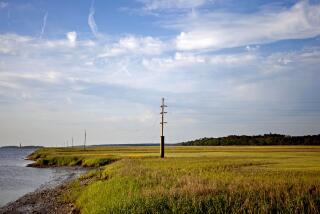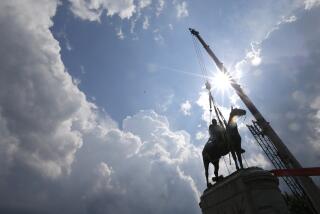As monuments to the Confederacy are removed from public squares, new ones are quietly being erected
Annette Pernell, a council member in this Texas town, was aghast when she heard about plans to construct a Confederate memorial that would be visible from the interstate and loom over Martin Luther King Jr. Drive.
But there was nothing she or anybody else could do about it. The land was private.
And so the Confederate Memorial of the Wind slowly went up on a grassy half-acre. A total of 13 concrete columns — one for each Confederate state — rise from a circular concrete pedestal. Eventually it will be surrounded by as many as 40 poles topped with Civil War battle flags.
“It’s as if we’ve gone backwards,” said Pernell, who is 54 and black. “I didn’t think, at this age, I would see what I’m seeing now. A Confederate memorial is a slap in the face of all Americans, not just African Americans.”
More than 150 years after Robert E. Lee’s surrender at Appomattox, local officials across the Deep South are removing contentious Confederate monuments from prominent perches in busy town squares and government buildings. In August, violence at a rally of white nationalists seeking to preserve a statue of Lee in Charlottesville, Va. — and comments by President Trump opposing its removal — brought renewed national attention to the issue.
A Confederate memorial is a slap in the face of all Americans, not just African Americans.
— Annette Pernell, resident of Orange
Less publicized has been the quiet rise of a new generation of Confederate markers — on private land, in cemeteries, on historic battlefields.
In South Carolina last month, a granite monument dedicated to the “immortal spirit of the Confederate cause” was unveiled on a spot where Civil War enthusiasts gather each year to reenact the Battle of Aiken. In Alabama in August, a gray stone memorial was dedicated in a private Crenshaw County park to unknown Confederate soldiers. In Georgia last year, a black marble obelisk was erected on public land in the mountain town of Dahlonega in memory of the county’s nearly 1,200 Confederate veterans.
In all, more than 30 monuments and symbols to the Confederacy have been dedicated or rededicated since 2000, according to the Southern Poverty Law Center. A historian at the University of North Carolina at Chapel Hill, W. Fitzhugh Brundage, conducted an inventory of his own state and found that 20 monuments had gone up there over that time — the most since the early 20th century.
The people funding the monuments — often the great-great grandchildren of Confederate soldiers — say they simply want to remember their loved ones and ensure their legacies live on. More controversially, many also promote a revisionist history in which slavery was not a major cause of the war.
“We just want to honor our ancestors,” said Hank Van Slyke, a 62-year-old engineering specialist and commander of a local Sons of Confederate Veterans brigade that put up the monument in Orange. The group is an association of male descendants of Confederate soldiers, and was formed in 1896 to hail the “hallowed memories of brave men” and “record of the services of every Southern Soldier.”
“Throughout history, whoever wins the war and conquers the nation, they get to write the history books,” he said. “We’ve always studied that we had a good cause and our ancestors fought for what they thought was right.”
We just want to honor our ancestors.
— Hank Van Slyke, Sons of Confederate Veterans
While most historians agree that the root cause of the Civil War was slavery, a significant number of Americans, particularly in the South, have been taught the war was about states’ rights in general. Six years ago, a Pew Research Center survey found that 48% of Americans said states’ rights were the reason for the war, while 38% cited slavery.
The debate is particularly charged in Texas, where the State Board of Education in 2010 adopted new academic standards listing slavery as third among the causes of the war, after sectionalism and states’ rights.
“There’s a kind of historical symmetry, in that many of these men now fighting the battle to defend the Lost Cause are predisposed to see themselves as under threat,” Brundage said.
The new monuments tend to be more modest than older ones. At the turn of the 20th century, when Confederate organizations enjoyed enormous cultural prestige in the South, large bronze and marble monuments were erected in conspicuous public spaces and etched with politically charged plaques. Now, Brundage said, they often focus less on defending the Confederacy and more on memorializing unknown soldiers or listing those who died.
Even in its unfinished state, the new Confederate memorial in Orange has stirred more public controversy than most new ones.
“We know this makes our town look bad,” said John “Jack” Smith, the city attorney for Orange, a town of 19,000 near the Louisiana state line whose motto is “Small town charm, world class culture.”
Smith said the monument didn’t reflect the values of Orange residents, and he slammed the Sons of Confederate Veterans as a “racist hate group.”
“We’re very concerned that this could send the wrong signal about Orange as people drive down the highway,” he said. “But what can we do about it? It’s a matter of free speech. We cannot stop them from building the thing on private land.”
Just over a third of Orange residents are black — a greater share than in any other town in the predominantly white county, which has long grappled with racism. In the 1990s, members of the Ku Klux Klan protesting federal attempts to integrate public housing held marches in the nearby city of Vidor, which was notorious as a “sundown town” because African Americans were not safe after dark.
In 2013, word spread that Granvel Block, then Texas division commander for the Sons of Confederate Veterans, had quietly bought a small plot of land near Interstate 10 for less than $10,000 and acquired a city building permit to construct a Civil War monument. The local chapter of the National Assn. for the Advancement of Colored People and several residents attended a City Council meeting to oppose the project.
The monument also sparked an online petition and an editorial from a local newspaper, the Beaumont Enterprise: “The last thing Southeast Texas needs is a large memorial to the Confederacy,” it said. “Simply put, it would be divisive and offensive.”
Still, when the newspaper conducted an online poll asking “Do you want a Confederate monument here?” more than 70% of respondents clicked “Yes. The Confederate Army and Civil War are part of our history.”
Block responded by publishing a lengthy “Call to Arms” on his group’s Facebook page.
“If we do not stand up when our ancestors are being attacked and break the stigma that our opponents attempt to attach to anything Confederate, we run the risk of everything Confederate as we know it, being condemned and exterminated,” he wrote. “These new Confederate memorials will be the turning point, and will open the doors and dialog for an accurate account of history to be taught.”
Rather than just follow the “easy path” of honoring ancestors “in the ways which are acceptable,” he argued, the group should focus on challenging the idea that the war was fought over slavery.
Yet in a sign of how controversial the monument has become, Block now declines to meet with reporters or speak on the record for fear of upsetting his wife.
In a telephone interview, Van Slyke, the local brigade commander, said that although slavery “may” have been a “small part” of the war, it was pretty far down the list.
Karen L. Cox, a history professor at the University of North Carolina at Charlotte, said that those putting up new monuments to the Confederacy represented a minority point of view.
“They continue to believe in the sort of version of history that mythologizes the Confederacy and its heroes, but it’s so obvious it’s disingenuous,” she said. “They’re not honoring history; they’re commemorating the principles and objectives of the war.”
While Orange city officials decided they could not legally stop the monument there, they sought to limit its impact by regulating the size of the Confederate flags and placing restrictions on parking. In 2013, the council passed an ordinance to limit flagpoles to 35 feet tall and ban any flags larger than 4 by 6.
While many people prefer not to talk about the monument, defenders aren’t hard to come by.
John Broussard, 54, an industrial electrician, and John Shaver, 33, a millwright machinist — both white — said those who criticized the monument, and its position near a street named after a slain civil rights leader, didn’t understand it.
“I don’t think it’s intended to be malicious to any race,” Shaver said. “A Confederate memorial on Martin Luther King Jr. Drive could bring the community and two racial groups together. Being a Confederate monument, the first thing that pops up in your mind is segregation and slavery, but it isn’t about that.”
Nathaniel Colbert, 68, an African American and retired plant operator who lives on the other side of the interstate less than a mile away, believes the monument was a deliberate insult.
At first, Colbert said, it really bothered him to drive by the memorial. Now he just whizzes on by in his pickup truck, barely noticing it.
“It’s an affront, but I’ve dealt with ignorance most of my life,” he said. “Right now, it’s just the beat of the drum.”
Jarvie is a special correspondent.
ALSO
White nationalist Richard Spencer to noisy Florida protesters: You didn’t shut me down
More to Read
Sign up for Essential California
The most important California stories and recommendations in your inbox every morning.
You may occasionally receive promotional content from the Los Angeles Times.






